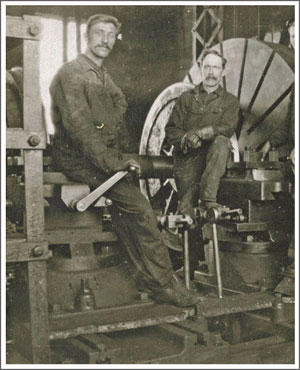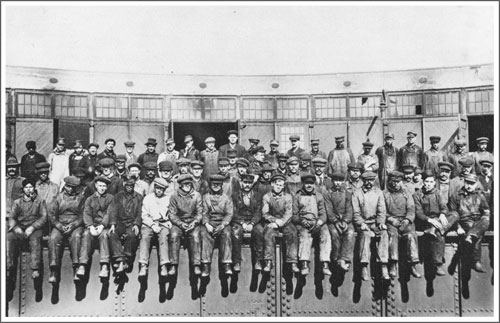|
The Rivers Roundhouse
And Shops
A component of…
The
Grand
Trunk Pacific Railway in Rivers, Manitoba
A Project
of The Rivers Train Station Restoration Committee
2014
The Rivers Roundhouse and Shops
In “The Story of Rivers” we learn that in 1908, “Now completed, or in
various stages of construction, were the mile-long trestle bridge
spanning the Little Saskatchewan valley, a two-story depot with its
Company offices, the roundhouse and shops, the terminal yards. And
nearby - a mushrooming settlement.”
As a divisional point of the new Grand Trunk Pacific, the town of
Rivers underwent a considerable building boom as the Railway began the
construction of buildings to service and store the many locomotives
that would be passing through. By 1909 up to 300 people were employed
in railway operations.

Image
1: The first roundhouse, under construction.
Photo
courtesy the Archives of Manitoba.

Image 2:
Motive-power required constant care and attention, to be kept ready for
duties on "the road." Above, an engine prepares to move off the
turntable.”
The most important structure was the Roundhouse. Roundhouses or
Engine Houses are large, circular or semicircular structures that were
traditionally located surrounding or adjacent to turntables. The
defining feature of the traditional roundhouse was the turntable, which
facilitates access when the building is used for repair facilities or
for storage of steam locomotives.
Early steam locomotives normally travelled forwards only; although
reverse operations capabilities were soon built into locomotive
mechanisms, the controls were normally optimized for forward travel,
and the locomotives often could not operate as well in reverse. A
turntable allowed a locomotive or other rolling stock to be turned
around for the return journey.

Image 3:
Workers in the “The Shops”.

Image 4:
The Shops

Image 5:
Some 250 to 300 men were employed in Rivers during the early railroad
operations at this point. Pictured here are some members of the machine
department.
In 1918 the roundhouse and machine shop were rebuilt and updated. Fire
damaged the newly completed structure but the building was saved. A
tornado destroyed one end of the building in August 1935 and a storm
buckled part of the roof in July of 1940. But it remained a vital part
of the railroad operation until the 1950’s when diesel locomotives were
introduced. These new engines required much less local maintenance.
Image 6:
An aerial view.
Image
7: In 1918 the roundhouse and machine shop were rebuilt.

Image 8:
Another view of the yards.
 Image
9: A busy workplace.
Image
9: A busy workplace.

Image 10: Engine and Coal Dock.

Image 11:
The modernized roundhouse
The Final Years
The era of the steam locomotive was coming to an end in the early
1950’s. New diesel engines were faster and stronger. They didn’t
require the types of local maintenance that the roundhouse and yards
had been providing. For a time these new engines used local makeshift
facilities in the roundhouse, but soon new liquid fuel tanks replaced
the coal dock and the roundhouse was no longer vital to operations.
Rivers was still a busy place. No less than twenty-eight crews (one
hundred and forty men) were operating between this point between
Winnipeg and Melville. An average of sixty carloads of ballast
material were being taken from the railway's gravel pit on a daily
basis as road beds needed constant attention.
But what we today call “downsizing” was inevitable. In 1954
twenty-three men - four roundhouse and eighteen car-department
employees - received termination notices from the Canadian National.
Another result of the increasing advances in locomotive technology was
that railway operations became centralized, and as a result the
divisional point was transferred to Terrace, and eventually all
maintenance was relocated to Prince George, BC and Edmonton, Alberta.
In 1958 the railway removed the sixty-foot high smokestack landmark
above the roundhouse. In 1961 it was sold to Structural Fabricators
Ltd. Which opened for business in the location the next year.
 Image
12:
The final days
Image
12:
The final days
|